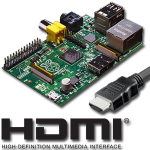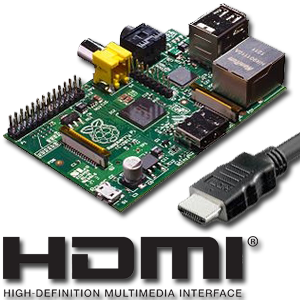 If you have ever played around with a Raspberry Pi, you have also experienced the ‘missing HDMI output’ issue.
If you have ever played around with a Raspberry Pi, you have also experienced the ‘missing HDMI output’ issue.
Basically, the HDMI output of the Raspberry Pi is only activated if a monitor or television is connected and powered up before the Raspberry Pi is turned on.
If you are using your Raspberry Pi with a television, this can be very bothersome. Fortunately, there is an easy fix which will force the HDMI output to be turned on, no matter if a screen is connected or not. By following these simple steps, you will be able to turn on your Raspberry Pi when the TV or monitor is turned off or not connected, and still get a working HDMI output when you turn on or connect a display afterwards.
Step by step solution: Force HDMI
- Power up your Raspberry Pi and open a terminal
- Open the Raspberry Pi configuration file for editing with this command:
sudo nano /boot/config.txt - Use arrows to get to the end of the file and add these 3 lines:
#Always force HDMI output and enable HDMI sound
hdmi_force_hotplug=1
hdmi_drive=2 - Save the changes by pressing CTRL + O
- Exit the editor by pressing CTRL + X
You can now reboot your Rapberry Pi and enjoy the possibility of hot plugging or turning on HDMI screen whenever you want, as the HDMI is forced to be always activated.
If you are using a normal monitor instead of a television, you may want to leave out the line ‘hdmi_drive=2’, as this forces HDMI mode rather than DVI mode. The main difference here is that HDMI mode enables sound through the HDMI connectection, which DVI does not.
I hope that this helps you to get rid of the bothersome and countless forced reboots caused when unintentionally starting the original Raspberry Pi image without a live HDMI screen connected.

It works like a charm, big thanks.
If I do this, the screen flickers. It rapidly switches between resolutions.
Hey, Thanks for this info! Fixed my pi’s no display output on my old TV
OK you guys… anybody running the Pi 7″ display? I tried this and it crashed my Pi!
Barry: I’m running a “generic” 7″ TFT display w/HDMI and this worked for me. Without this, it would only work if the TFT was powered up first, before booting the Pi.
How do I do this as I currently can’t connect to any screens to actually be able to interact with the pi
You need to connect it to a wired network and ssh into it from a computer on the same network.
I have a rasppberry pi B and the pi isn’t sending an HDMI signal to the monitor. I tried it on a Kedei 3.5 inch monitor and that doesn’t work either. I can’t add any lines to the computer if I can’t see it on a monitor. Please help. Thank you.
im having that same problem
How will I open a terminal on my raspberry pi if the hdmi is not working so I cannot use any monitor?
Grateful for the information. I got the editor via programs/myosmc/pi Config/config editor as outlined.
this worked to resolve the latest raspberry pi 3 updates (raspbrian stretch) running kodi.
Why they’d not force hdmi as a default, I don’t know.
Thanks a ton.
I’m using recalbox I don’t know how to find the file when I’m on the computer. On the retropi 3 I open the command prompt and enter in the sudo nano command line like it says up top and it says not found. So then what?
“nano” is a text editor.
try to install it first:
sudo apt-get install nano
how about just force the display via hdmi and sound ould go through usb sound
Thanks for the information, the config editor can be reached through programs/myosmc/pi Config/config editor.
Input the text as described.
Hi. My pi is doing the same, which is a raspberry pi zero. But I can’t find the config.txt file on the sd card! Please help!
been trying for 3 days to get sound on my raspberry pi 0
this worked wish i had found this 1st
Thank you for the feedback.
Good to know that this also works for HDMI problems on the Raspberry Pi Zero.
owe you a beer! thanks for this!!
This worked a treat! the HDMI already kind of worked on my Pi2, but the audio was an issue.Not any more! I can now play arcade games with full 8 or 16 bit glorious sound!!
Thanks!
I’d love to fire up the terminal and edit the boot config. If only i had some way of seeing whats on the screen.
You should be able to SSH into the Pi and do this ..
Sorry, im a complete newbie with the raspberry. What is SSH?
SSH is a tool for connecting to a computer remotely. You can download ssh putty to Windows and find out your rasp pi IP address to connect
I think that you might be able to modify the config file by plugging the SD card into a laptop and locating the config file on the directory… But I’m not certain. I’ll probably have to try this when I’m home later
Plug into your network and then from a terminal (putty on windows) write in ssh pi@raspberrypi enter raspberry as a password, then you have SSH access. unless you already figured this out.
Thats not the only problem with the HDMI output from the PI. We have had 2 recently with no HDMI output, both had dry joints (badly soldered component legs) on the HDMI connector, luckily we have the equipment here to rework the connectors affected. This looks like it might be a common fault on the newer pcb’s.
Thanks for the heads up! May I ask from where you got these troublesome raspberry pi’s?
Also, could you elaborate on how and where to spot the problem, in case others are in doubt if this is the issue they have?